Contact lenses bring a plethora of benefits to most people who wear them, but contact lens irritation can really ruin the experience, along with your entire day. If you experience contact lens irritation, it is important to figure out the cause, as it can be a warning sign for some pretty serious conditions.
In this article, I will discuss the top 15 causes of contact lens irritation for general knowledge and preventative purposes. After reading this article, you will be in a better position to recognize the causes of contact lens irritation, but if you’re currently experiencing problems with your contact lenses, this article is not a substitute for going to see your eye care professional.
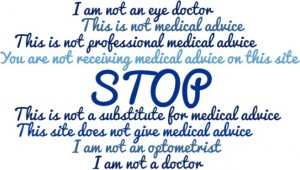
I am not a doctor. The information provided on this page is for general educational purposes only. You are not receiving medical advice or being given a diagnosis on this site. Please read Contacts Advice Terms of Usebefore continuing.
1. Something stuck under your contact lens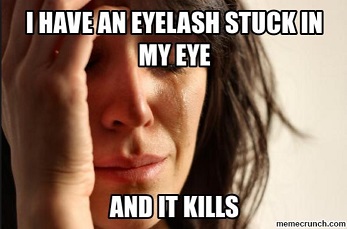
Everyone who wears contact lenses has experienced this at some point. Whether it’s a hair, an eyelash, or a grain of sand, it all pretty much feels the same; it hurts.
Luckily, the irritation caused by this is usually short-lived and it is not an indication that there is something wrong with your eyes or your contact lenses. It’s just one of the things that can happen to anybody with a bit of bad luck.
Typically, this type of irritation will pass as soon as the trapped object escapes from under your contact lens. This will either happen on its own within a few seconds, or it can helped along if you gently move your contacts around.
For really stubborn cases, it may be necessary to remove the contact lenses altogether, rinse both the contact lenses and your eye, and then reinsert.
For those really struggling with luck, it is possible the object trapped underneath your contact lenses to create a scratch on your cornea. If this has happened to you, you will still feel like there’s something in your eye even after you’ve removed your contact lenses. Additionally, the affected eye is typically very teary, light sensitive, and red.
Corneas will typically heal from such an incident within 24-48 hours, however, it’s never a bad idea to visit your eye doctor to have it checked out. He/she may prescribe you pain-killing eye drops for comfort and antibiotic drops to prevent the would from getting infected.
2. You have dry contact lenses
Contact lenses drying out is by far and away the most common cause of irritation from contact lenses. In fact, it’s so common and sometimes so severe that it’s also the #1 reason why people drop out of contact lenses for good.
Anybody can be afflicted by dry contact lenses, but people with dry eyes in general are much likely to suffer from it.
To help reduce the likelihood of dryness while wearing contact lenses, here’s a few tips:
- Treat the underlying dry eyes
- Switch to an appropriate brand
- Make use of re-wetting drops
3. Deposits on your contact lenses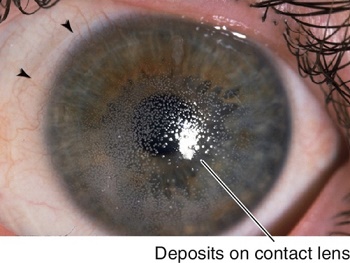
Certain people are known as ‘depositors’ and they tend to produce a lot of protein in their tears that end up accumulating on their contact lenses. The nature of these proteins makes it such that they cannot be removed, even when rubbing with contact lens cleaning solution.
Deposits tend to build up to levels that can cause irritation near the end of the month (for monthly contact lens wearers). Heavy depositors can even have problematic deposits on their lenses after just a few days of wear. These people would do much better in daily disposable contact lenses.
4. Sleeping in your contact lenses
Most people are not approved by their eye doctor to sleep in their contact lenses but do so anyway. That’s understandable, life happens. Just don’t be too surprised if wake up with massively dry and irritated eyes.
There are brands of contact lenses that are designed for you to sleep in for up to 30 days consecutively without causing any irritation. The most popular one is Air Optix Night & Day Aqua. However, it takes more than just wearing this brand to successfully wear contacts overnight.
To be approved by your eye doctor and sleep with your contact lenses problem-free, you have to have very (very!) healthy eyes. Ideal candidates are usually in their late teens, early twenties and have perfectly healthy eyes.
For the rest of us, try to avoid sleeping in your contact lenses as much as possible, otherwise, be sure to have those eye drops handy.
Click here to learn more about sleeping in contact lenses.
5. Wearing inverted contact lenses
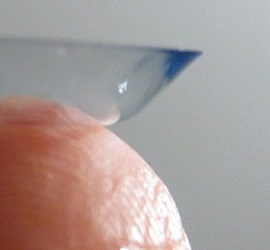
Contact lenses are designed to be worn in a certain position. However, since they are soft and flimsy, they can occasion flip inside out. Attempting to wear inside-out contact lenses will result in immediate physical irritation and blurriness.
It is not always easy to tell if contact lenses are inside-out or not. That’s why I have made this guide with 5 easy techniques you can use to easily tell if your contact lenses are inside-out.
They are:
- Edge Shape
- The Taco Test
- The Easy Flip Test
- Keep the Original Orientation
- The Last Resort
Click here to learn more about these techniques.
6. Reaction to contact lens solution
Contact lens solutions do not always agree with everybody. Due to the ingredients (namely the preservatives) found in the different contact lens solutions, some people will experience an allergic reaction every time their eyes touch the solution.
When this happens, it is usually upon insertion of the lenses and doesn’t typically last longer than 30 minutes.
The only solution to this problem is to consult your eye care professional about which brand would be more appropriate for you to use (and then switch brands, obviously).
Often times, your eye doctor will recommend that you switch to a preservative free hydrogen peroxide brand.
Unfortunately, even those who wear daily contact lenses are not immune to this problem. Even though they don’t require the use contact lens cleaning solution, some people may be allergic to the solution inside the little plastic blister packs that house every contact lens.
If this is the cause of your irritation, the easiest solution is to switch to a different brand. Alternatively, you could purchase contact lens cleaning solution (that you’re not allergic to) and clean off the blister pack solution before you put the contacts in your eye. I don’t know anyone who would want to do it this way, but technically it is an option.
7. Giant Papillary Conjunctivitis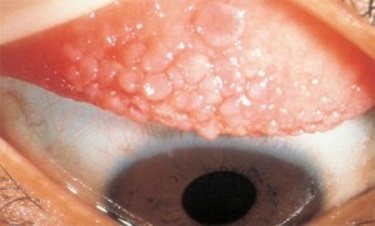
Giant Papillary Conjunctivitis (GPC) is a condition that is characterized by large bumps underneath the eyelids. GCP in various early stages is more or less expected in all full-time contact lens wearers at some point. It is not considered to be problematic until its more advanced stages where the bumps can interfere and displace the contact lens with every blink.
If you develop GPC to the point where it is constantly causing irritation with your contact lenses, unfortunately, the only way to improve the situation is staying out of contact lenses for a few weeks, sometimes even months.
Upon your return to contact lenses, it is important to select a brand and wearing schedule that will minimize the irritation to you eyelids as much as possible in order to prevent the GPC from returning.
8. Meibomian Gland Dysfunction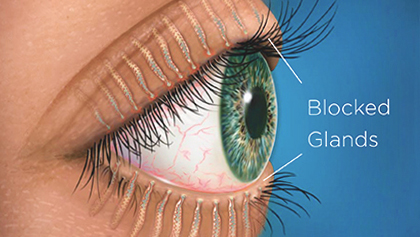
Meibomian Gland Dysfunction (MGD) is an extremely common eyelid condition that affects the strength and integrity of your tear film (the thin layer of tears that lubricates the surface of your eyes).
Having a compromised tear film due to MGD will greatly increase your risk of dry eyes and consequently, contact lens irritation.
The good news about MGD is that it is reversible. To learn more about MDG prevention and how you can treat it to improve your contact lens wearing experience, read this article on how to improve dry eyes with contact lenses.
9. You have a corneal infiltrate/ulcer
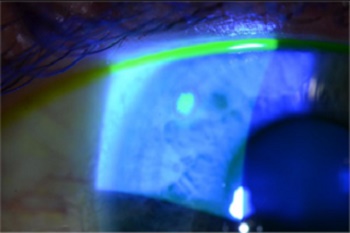
This is the most serious of all the causes of contact lens irritation.
A corneal infiltrate is tiny little white spot embedded inside your cornea, and it is a sign that your cornea has been chronically irritated for a long time. The white spot represents an accumulation of tiny white blood cells which are sent out by the body to combat a perceived threat, in the case, your contact lenses.
When a corneal infiltrate is present, your eyes will look and feel irritated, especially when your contact lenses are in.
A corneal infiltrate must be treated by an eye care professional. He/she will typically ask you to stay out of contact lenses for a while, and take anti-inflammatory eye drops to help the infiltrate resolve.
A corneal ulcer is even more serious. For contact lens wearers, it usually means that a bacteria are eating away at your corneal tissue. Corneal ulcers are sight threatening if not treated appropriately by your eye care professional.
10. You have loose contact lenses
When your contact lenses fit appropriately, or they’re a little tight, you typically don’t feel any discomfort. However, if your contact lenses are too loose, they are constantly moving around on the surface of your eyes and cause a lot of irritation.
The irritation caused by a loose fitting contact lens is not typically as painful as getting something stuck under a contact lens, rather, it is just a constant reminder that there’s something floating around in your eye.
A classic sign of your contact lenses being too loose is if they fall out of your eyes on their own. However, don’t get this confused with extreme dryness, which can also cause your contact lenses to fall out on their own.
Loose contact lenses need to be refit by your eye care professional. Typically, he/she will refit you into a lens with a smaller base curve, which causes the lenses to fit tighter.
11. Poor quality contact lenses
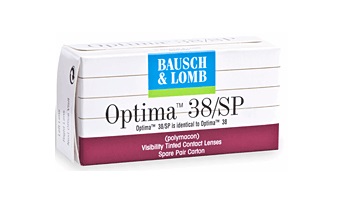
This one is a little vague, but there is no denying that contact lenses have evolved and improved over the ages. If you’re using some relic contact lens from the late 90’s or 2000’s, it’s time that you looked into upgrading to something that’s better for your eyes.
Nowadays there is a contact lenses designed for almost everybody out there. There are brands with extended ranges to accommodate those with higher prescriptions, brands for people with dry eyes, brands that relax the eye muscles when you’re staring at a computer screen, brands that filter out UV light as well as harmful blue light, etc.
With today’s selection, there’s no reason for you to be stuck in the stone age of contact lenses.
12. Color contact lenses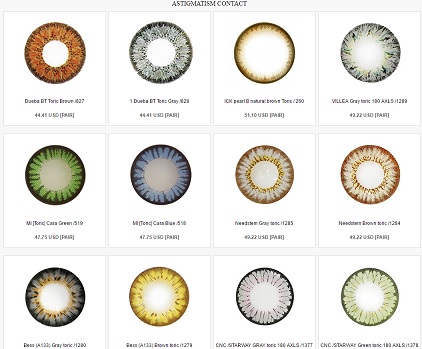
Color contact lenses are notorious for causing irritation. The vast majority of contact lenses available on the internet are made from low-quality materials and have the paint on the exterior of the contact lenses.
There is a brand called Air Optix Colors by Alcon which was designed to remedy the common issues with conventional color contact lenses. It is made of a high quality, breathable material, and the color is embedded within the contact lens which means it never interacts with your eyes.
Click here to learn more about Air Optix Colors.
13. Your contact lenses are getting too old
For the most part, contact lenses designed to last for 1 month will remain comfortable for 1 month. You may notice a slight drop in comfort by the last few days, but nothing too serious.
If you forget to change your contacts when you’re supposed to, or you do it on purpose, that’s when your contact lenses can really start causing your eyes a lot of irritation.
The solution? Don’t stretch your contact lenses.
Stretching the life span of every contact lens is a technique employed by some wanting to save money on their annual cost of contact lenses. I’m all for saving money, but not at the expense of the health of your eyes.
Saving money on contact lenses the smart way is making sure that you buy your contact lenses at the lowest price possible. Most people don’t know that they overpay for their contact lenses by as much as 100%!
Contacts Advice is a contact lens price comparison site dedicated to finding the lowest price on the internet for every single contact lens brand. Make sure you consult Contacts Advice price comparison table before you make your next contact lens purchase.
To make sure that you’ve considered all the factors such as volume discounts, shipping, handling, and processing fees, contact me for a FREE contact lens price consult.
14. Your contact lens is torn or ripped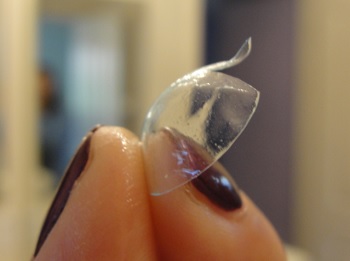
A rip or a tear in a contact lens can feel almost exactly like an eyelash trapped under your lens. It’s painful, and also introduces the risk of getting a scratched cornea due to the blunt edges created by the rip.
If your contact lens is painful to wear, remove it and inspect it closely for any rips or torn edges. If you see any damage to your lens, discard it and wear a new one.
If you’re positive that there is no damage to your lens, the pain was probably from a foreign body under your contact lens. Rinse it thoroughly with a contact lens clean solution to dislodge any potential debris on the lens, and instil a few lubricating eye drops into your eye.
If your contact lenses are constantly ripping, this is not normal. Either you are manipulating them wrong when you insert, remove and clean them, or you have a defective batch. If you think you have a defective batch, try contacting the manufacturer to get a new box sent to you.
15. Your contact lenses are in the wrong eye
Inserting your right contact lens into your left eye, and vice versa may not cause physical irritation to your eyes, but can certainly cause visual irritation and headaches.
Typical symptoms of wearing your contact lenses in the wrong eye are strained vision, blurry vision, and headaches.
Once you lose track of which contact lens goes in which eye, it can get a little confusing, especially if the prescription in both of your eyes is very similar.
If all hope is lost and you feel like you’ve tried wearing every combination, start from scratch and start a new pair of contact lenses. Just make sure that your boxes are properly labeled with ‘Left’ and ‘Right’.






Leave a Reply